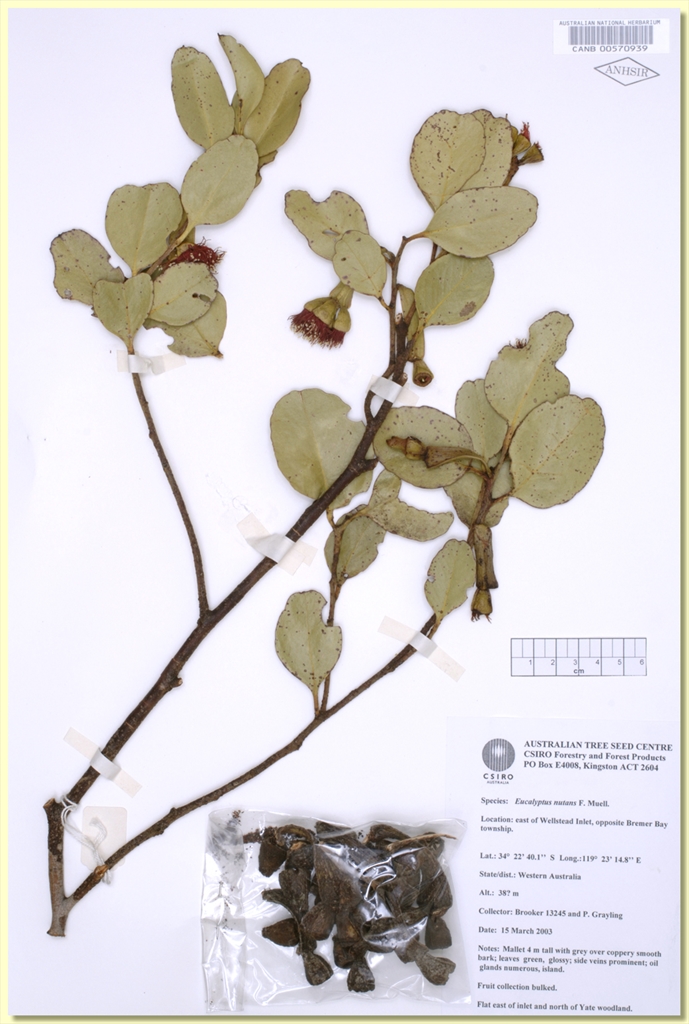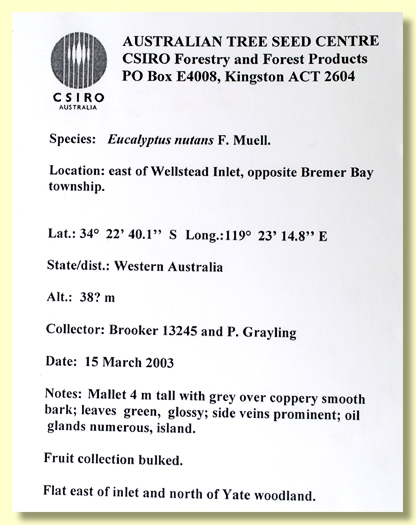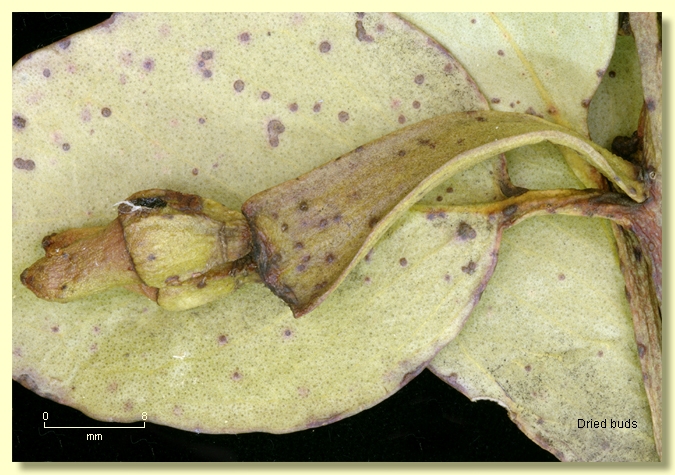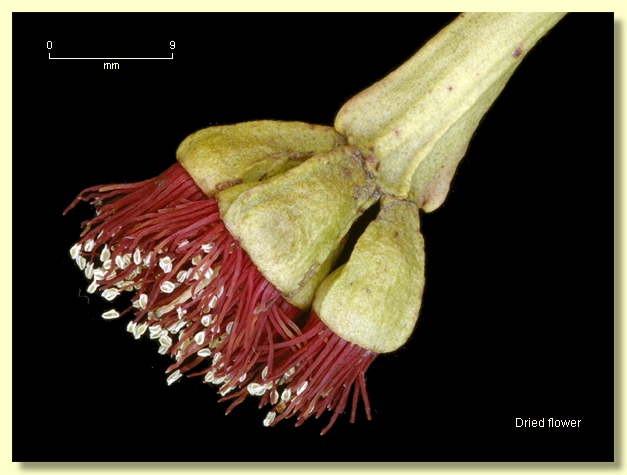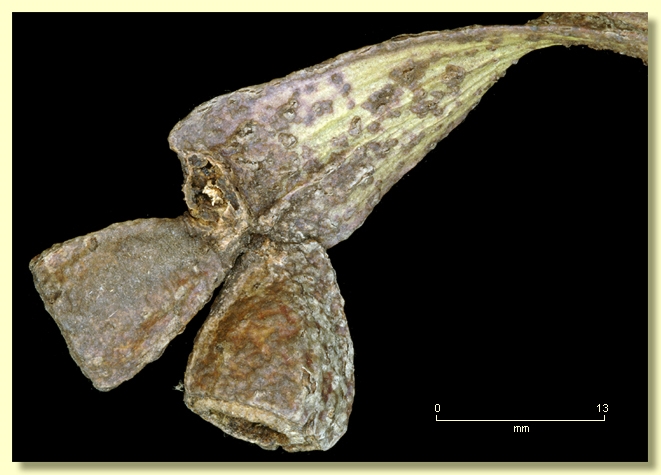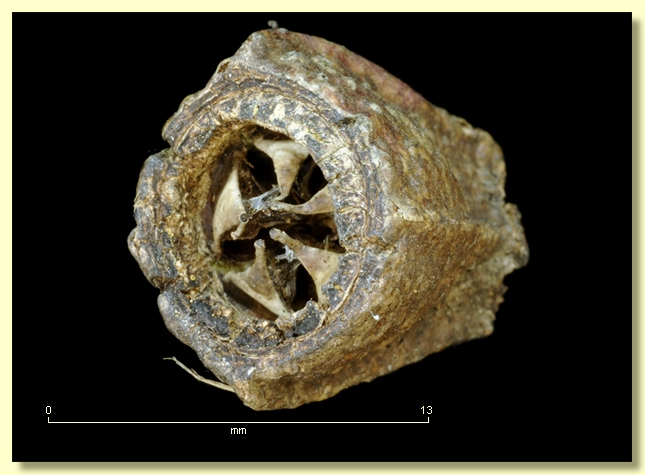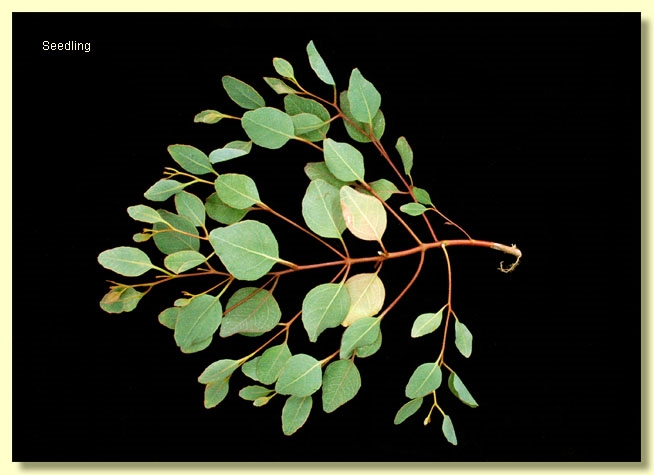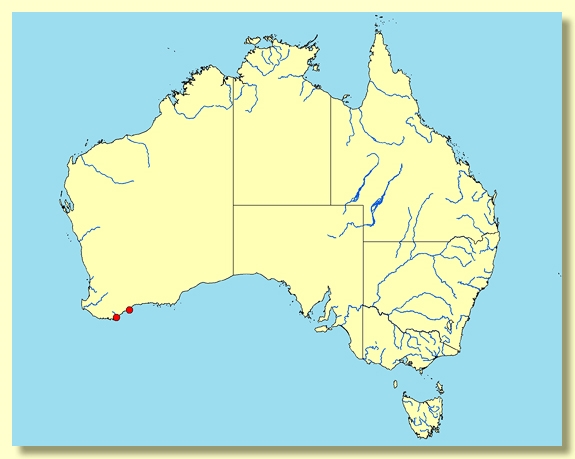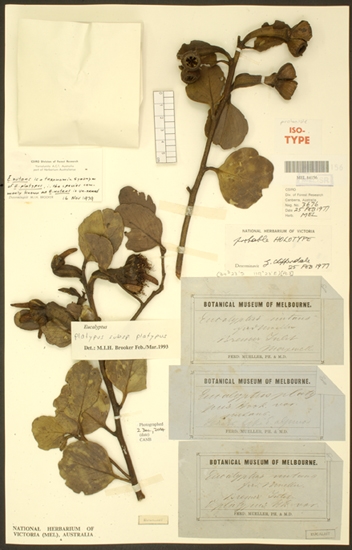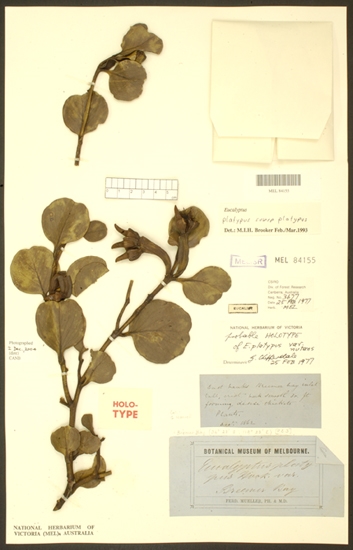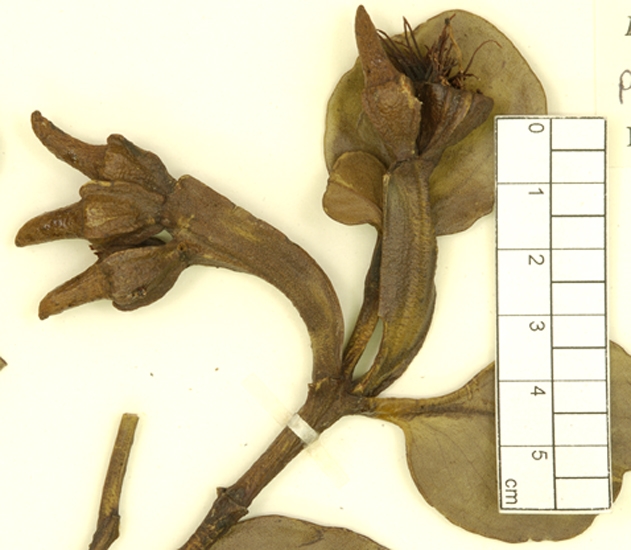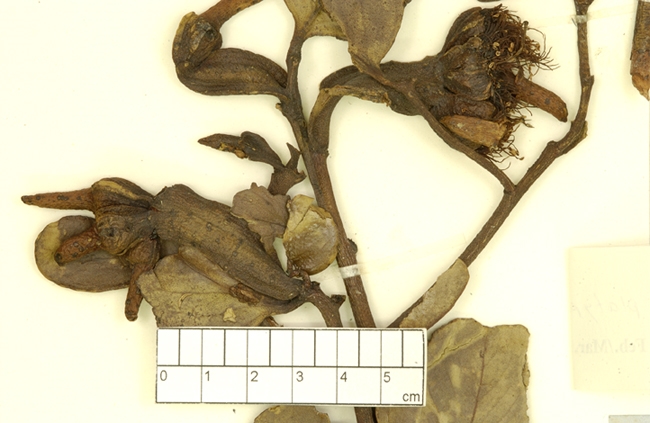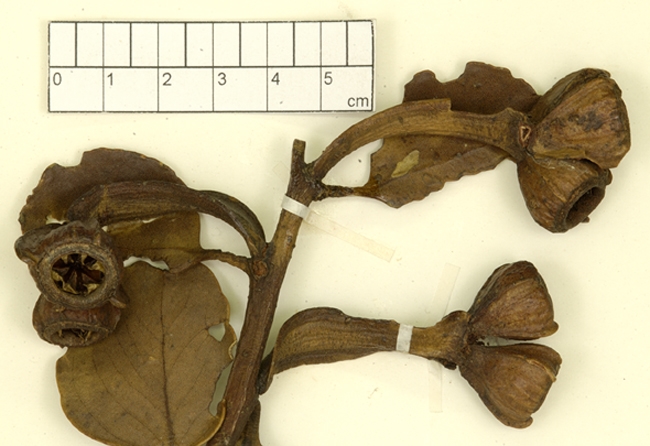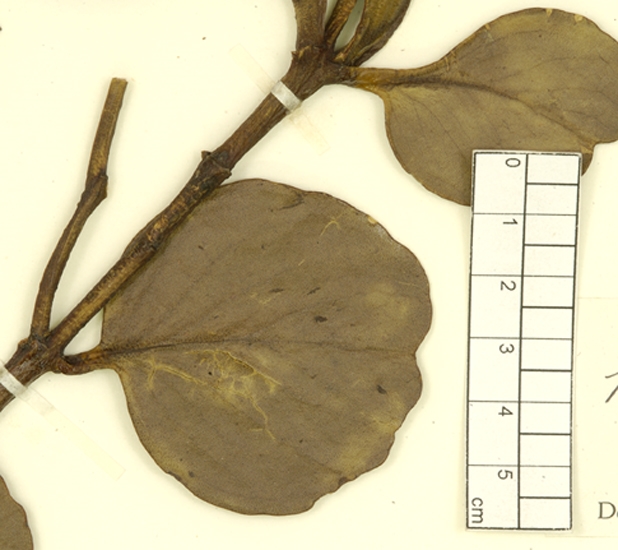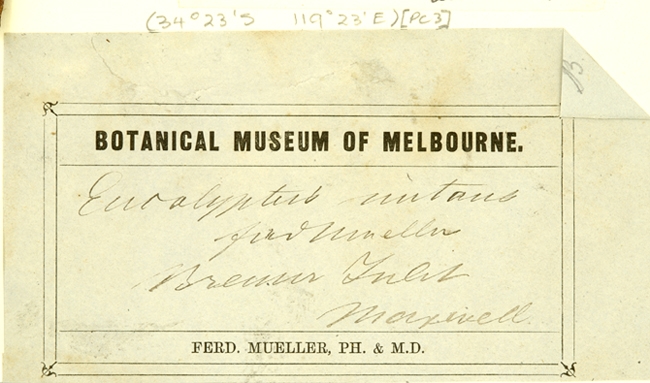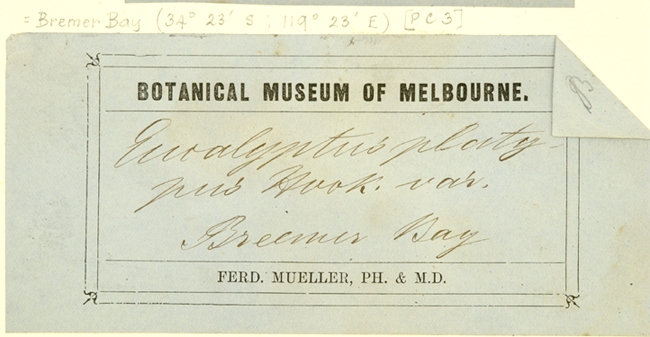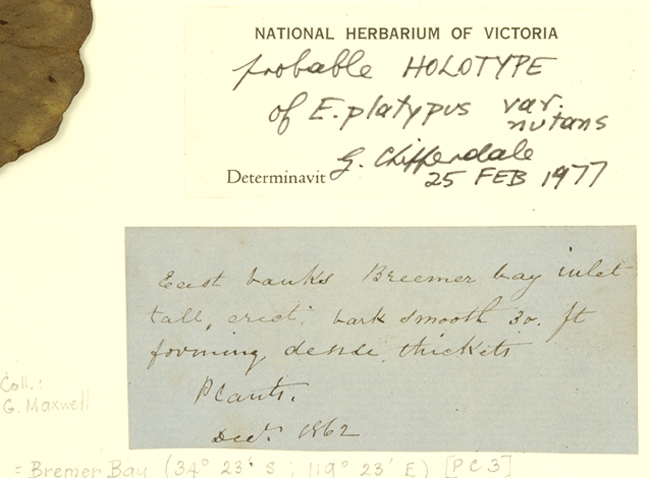Eucalyptus | Symphyomyrtus | Bisectae | Glandulosae | Erectae | Abundae
Euclid - Online edition
Eucalyptus nutans
Mallet (single-stemmed small tree branching low) to 3 m tall, trunk slender. Lignotuber absent.
Bark smooth throughout, shiny, grey over pink-orange and coppery.
Branchlets with oil glands in the pith.
Juvenile growth (coppice or field seedlings to 50 cm): not seen.
Adult leaves alternate, petioles (0.4)0.7–1.5 cm long; blade elliptical to oblong or sub-orbicular, 2.4–7.0 cm long, 2.5–6.0 cm wide, base truncate or broadly tapering to petiole, margin distantly indented, apex shallowly emarginate or sometimes rounded, concolorous, green, glossy, side-veins at ca 45° to the midrib, intramarginal vein remote from margin, reticulation obscured by numerous round oil glands.
Inflorescence axillary unbranched, peduncles spreading or down-turned, 2.0-4.0(6.0) cm long, strap-like (to 1 cm wide); buds 7 per umbel, normally sessile, rarely pedicels to 0.2 cm long. Mature buds shape difficult to describe (overall 1.8 cm long, 0.8–1 cm wide), the base of bud truncate-obconical with the operculum narrowed suddenly to form a horn shape and approximately the same length as the hypanthium (base), scar present (outer or sepaline operculum shed early), hypanthium with 3–6 prominent longitudinal ridges, stamens erect, anthers narrowly oblong, versatile, dorsifixed, dehiscing by longitudinal slits, style long and straight, stigma blunt, locules 5(6), the placentae each with 4 or 6 vertical rows of ovules. Flowers with red or pinkish filaments and cream anthers.
Fruit normally sessile, rarely shortly pedicellate with pedicels only 0.2 cm long, cupular-obconical, 1.2–1.6 cm long, 1.4–1.9 cm wide, disc descending, valves 5(6), at rim level.
Seeds blackish grey, 1–2 mm long, flattened-ovoid, dorsal surface shallowly reticulate, hilum ventral.
Cultivated seedlings (measured at node 10): cotyledons Y-shaped (bisected); stems rounded in cross-section, very warty; leaves always petiolate, opposite for ca 6 nodes then alternate, broadly ovate, ca 3.5 cm long, 3–3.2 cm wide, base rounded, apex blunt, dull, green, very warty on surfaces and margins for at least 10 nodes. Wartiness is due to raised oil glands..
Flowering has been recorded in March.
A small mallet of very restricted distribution in southern coastal Western Austtralia, known with certainty from three localities, just east of Albany, near Bremer Bay and south of Ravensthorpe. Eucalyptus nutans has glossy green rather short and broad adult leaves with numerous oil glands obscuring the venation, bud clusters on flattened peduncles to 1 cm wide, buds with the operculum abruptly contracted, flowers with red/pink stamens bearing white anthers and sessile fruit with 5(6) valves.
E. nutans is clearly related to the well known E. platypus, differing in the shorter operculum (in E. nutans operculum ca 1 cm long, about the same as the base of the bud or hypanthium, in E. platypus the operculum is 1.3–2.4 cm long and ca 1.5 to 3 times the length of the hypanthium), also differing in flower colour (usually creamy white to lemon-green, rarely pink-red in E. platypus), and the number of valves in the fruit (usually four in E. platypus, rarely more). E. platypus has a more inland distribution on heavy soils.
The coastal species E. utilis differs from E. nutans in having more lanceolate adult leaves, buds with longer operculum, creamy white flowers, fruit with only three or four locules, and a coastal sand dune habitat.
The only other species likely to be confused with E. nutans is the small marlock E. vesiculosa which is similar in habit, adult leaves and flower colour but differs in having a shorter operculum covered in coarse warts and the stamens being completely inflexed in bud, not erect.
Operculum length relative to hypanthium
Flower colour
Fruit width cm
Adult leaf shape
nutans
operculum = hypanthium
red or pink-red
1.4–1.9
elliptic, oblong, suborbicular
platypus (both subspp.)
operculum 1.5–3 times hypanthium
pale yellow-green, rarely red
0.8–1.3
elliptic to orbicular
utilis
1.2–2.3 times hypanthium
creamy white
0.7–1.0
ovate to lanceolate
Eucalyptus nutans was not included in the classification of Brooker (2000) but would be best positioned alongside Eucalyptus platypus in Eucalyptus subgenus Symphyomyrtus section Bisectae subsection Glandulosae because the buds have an operculum scar, cotyledons are bisected and branchlets have oil glands in the pith. Within this very large subsection, E. nutans is only closely related to E. platypus and E. utilis, having similar general habit, four-angled buds in clusters of seven on conspicuous broadly flattened and often long peduncles, erect stamens, and highly glandular leaves with indented margins.
The name E. nutans was misapplied for many years to a red-flowered mallee species closely related to and for a while included also under the name E. cernua, but now correctly named Eucalyptus proxima (see Nicolle & Brooker (2005) for further discussion). [Eucalyptus proxima has lanceolate adult leaves and inflexed stamens, and occurs from the Mt Desmond and Jerdacuttup area south-east of Ravensthorpe.]
Eucalyptus nutans : Latin nutans, nodding, referring to the spreading- to down-turned axillary inflorescences.

